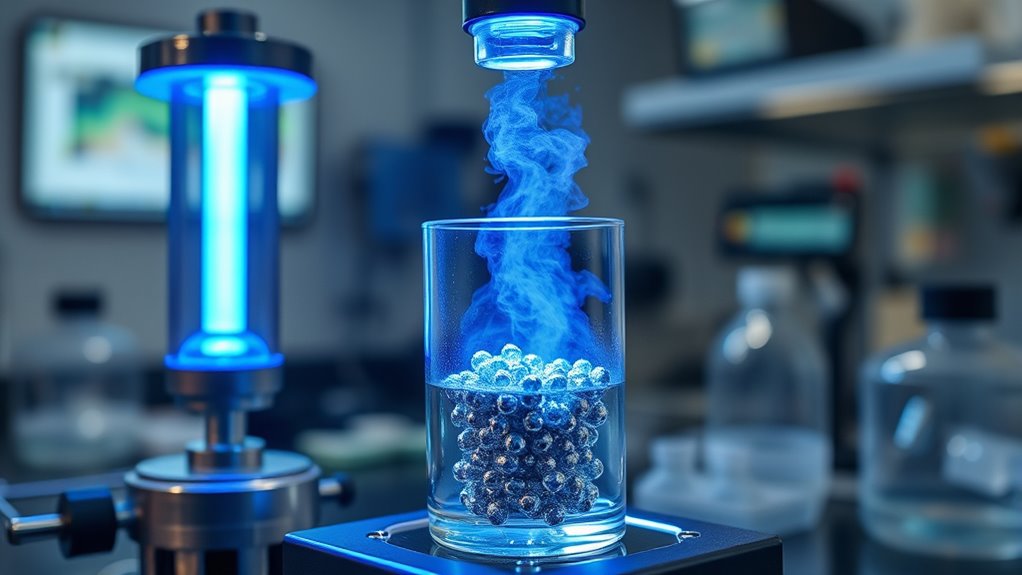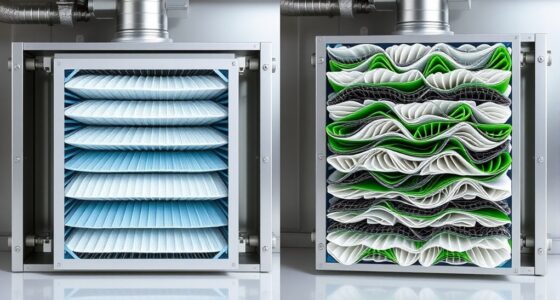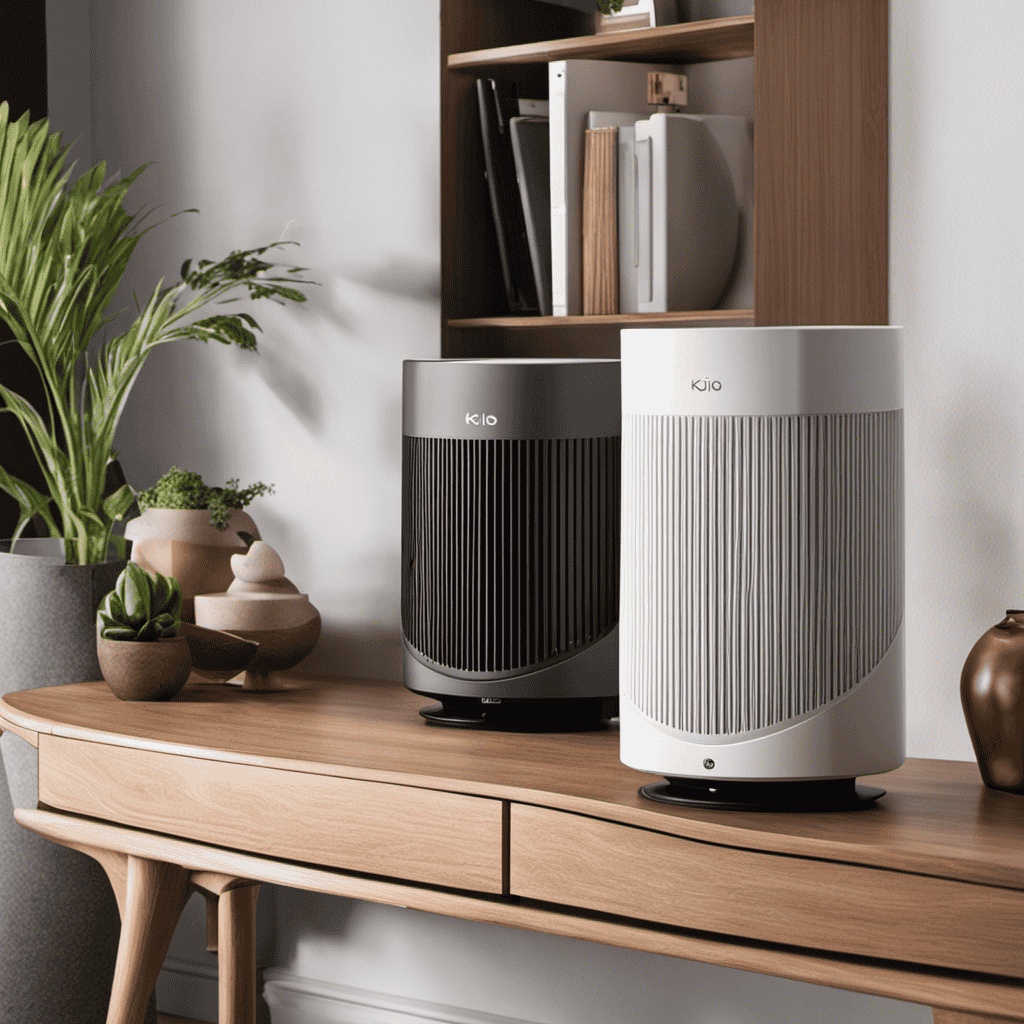Photocatalytic oxidation shows real promise as a sustainable method for degrading pollutants using light energy, especially through materials like titanium dioxide. It offers environmental benefits such as reducing air and water contaminants with minimal secondary waste. However, challenges like catalyst stability and cost limit its current widespread use. While it’s gaining attention in industry, further advancements are needed before it can be seen as a true breakthrough. To understand if it’s the future of pollution control, explore the details ahead.
Key Takeaways
- Photocatalytic oxidation (PCO) shows significant promise for environmental cleanup, but still faces technical and scalability challenges.
- Many claims of breakthroughs are driven by hype; real-world effectiveness requires rigorous validation.
- Advances in catalyst stability and visible-light activation are crucial for transitioning from lab to industry.
- Its eco-friendly, solar-powered approach makes PCO a promising sustainable technology, but cost remains a barrier.
- Overall, PCO has potential as a genuine environmental solution, but its success depends on overcoming current limitations.

Have you ever wondered how certain materials can use light to break down pollutants? Photocatalytic oxidation is an innovative process that harnesses light energy to trigger chemical reactions, decomposing harmful substances in the environment. This technology relies on photocatalysts—usually semiconductors like titanium dioxide—that, when exposed to light, generate reactive species capable of attacking pollutants. Its potential to address pressing environmental concerns has sparked notable interest, especially in tackling air and water contamination. But as with many emerging solutions, it’s essential to evaluate whether photocatalytic oxidation truly offers a sustainable breakthrough or if it’s just another buzzword.
Exploring how light-driven photocatalytic oxidation tackles pollution sustainably and effectively.
The environmental impact of photocatalytic oxidation is promising. It offers a clean, energy-efficient way to degrade organic pollutants without producing secondary waste. Unlike traditional chemical treatments that often involve harsh reagents or produce sludge, photocatalysis uses light—preferably sunlight—making it a green alternative. This process can be employed in water treatment plants to break down toxins, bacteria, and viruses, substantially improving water quality. Similarly, in air purification systems, photocatalytic filters can neutralize airborne pollutants like volatile organic compounds (VOCs) and NOx gases, reducing smog formation and improving air quality. These applications demonstrate how photocatalytic oxidation can contribute to a healthier environment by lowering pollutant levels and minimizing ecological footprints.
Industrial applications of photocatalytic oxidation are expanding rapidly due to its versatility and efficiency. Industries such as manufacturing, automotive, and waste management are exploring how to incorporate photocatalytic materials into their processes. For example, photocatalytic coatings are applied to building surfaces and urban infrastructure to passively break down pollutants over time, reducing the need for energy-intensive cleaning. In the domain of air purification, photocatalytic filters can be integrated into ventilation systems, continuously cleaning indoor air. The technology also finds use in self-cleaning surfaces, which stay free of grime and bacteria without harsh chemicals. As industries aim for sustainability, photocatalytic oxidation offers an attractive solution to meet stricter environmental regulations while maintaining operational efficiency. However, challenges remain, such as improving catalyst stability, increasing efficiency under visible light, and scaling the technology cost-effectively. Additionally, advances in solar power can enhance the efficiency of photocatalytic systems by providing sustainable energy sources for activation and operation.
While photocatalytic oxidation holds notable promise, it’s essential to approach it with a balanced perspective. Its environmental impact is undeniably positive when properly implemented, but widespread adoption depends on overcoming technical hurdles and economic considerations. As research advances, it’s becoming clearer that photocatalysis could become a key component in cleaner industrial processes and environmental remediation strategies. Whether it’s a breakthrough or merely a buzzword hinges on how effectively we can translate laboratory success into real-world, sustainable solutions. For now, it remains an exciting frontier that could redefine how industries and communities combat pollution in the future.
Frequently Asked Questions
What Are the Main Environmental Benefits of Photocatalytic Oxidation?
You’ll see that photocatalytic oxidation offers significant environmental benefits, making it a promising sustainable solution. It actively degrades pollutants in air and water, reducing harmful emissions and contaminants. This process uses sunlight, so it minimizes energy consumption and chemical use. By enabling effective pollutant degradation, it helps improve air and water quality, supporting healthier ecosystems and communities. It’s a technology that truly aligns with eco-friendly, innovative environmental protection efforts.
How Does Photocatalytic Oxidation Compare to Traditional Air Purification Methods?
You might think traditional air purification methods are enough, but photocatalytic oxidation offers a game-changing edge. Its high photocatalytic efficiency breaks down pollutants more thoroughly, and it does so at a lower cost, making it more sustainable long-term. While conventional filters trap particles temporarily, photocatalytic oxidation actively destroys harmful compounds, providing cleaner air. Don’t overlook this innovative approach—its potential to revolutionize air purification is truly worth considering.
Are There Any Health Risks Associated With Photocatalytic Oxidation?
You might wonder about health concerns with photocatalytic oxidation, especially regarding chemical exposure. While it’s generally safe, some worry about potential byproducts like formaldehyde or ozone formation during operation. It’s important to guarantee proper system design and ventilation to minimize risks. Overall, with appropriate use, photocatalytic oxidation can be effective, but staying informed about chemical exposure and possible emissions helps protect your health.
What Industries Are Currently Implementing Photocatalytic Oxidation Technologies?
Imagine towering factories and bustling labs where photocatalytic coatings are quietly transforming the air. You see industries like automotive, water treatment, and building construction adopting these technologies to improve air quality and reduce pollutants. Their industrial applications showcase a growing trend, with companies harnessing photocatalytic oxidation to create cleaner environments. As this trend accelerates, you can’t help but wonder—will it revolutionize pollution control or remain just a fleeting buzzword?
What Are the Limitations or Challenges of Commercializing Photocatalytic Oxidation?
You face several challenges when commercializing photocatalytic oxidation, mainly scalability issues and cost barriers. Scaling up technology from lab to industry can be difficult due to inconsistent performance and material durability. Additionally, high costs of catalysts and implementation hinder widespread adoption. These obstacles slow down progress, making it harder to prove the technology’s long-term viability and affordability for large-scale applications.
Conclusion
You might think photocatalytic oxidation is just a passing trend, but it’s more like a lighthouse guiding us through foggy waters. Just last year, a small startup reduced airborne pollutants in a busy city by 70% using this technology—proof it’s not just hype. As with that lighthouse, it’s about clarity and direction. So, don’t dismiss it as buzz; with real-world impact, it’s lighting the way toward cleaner air.









